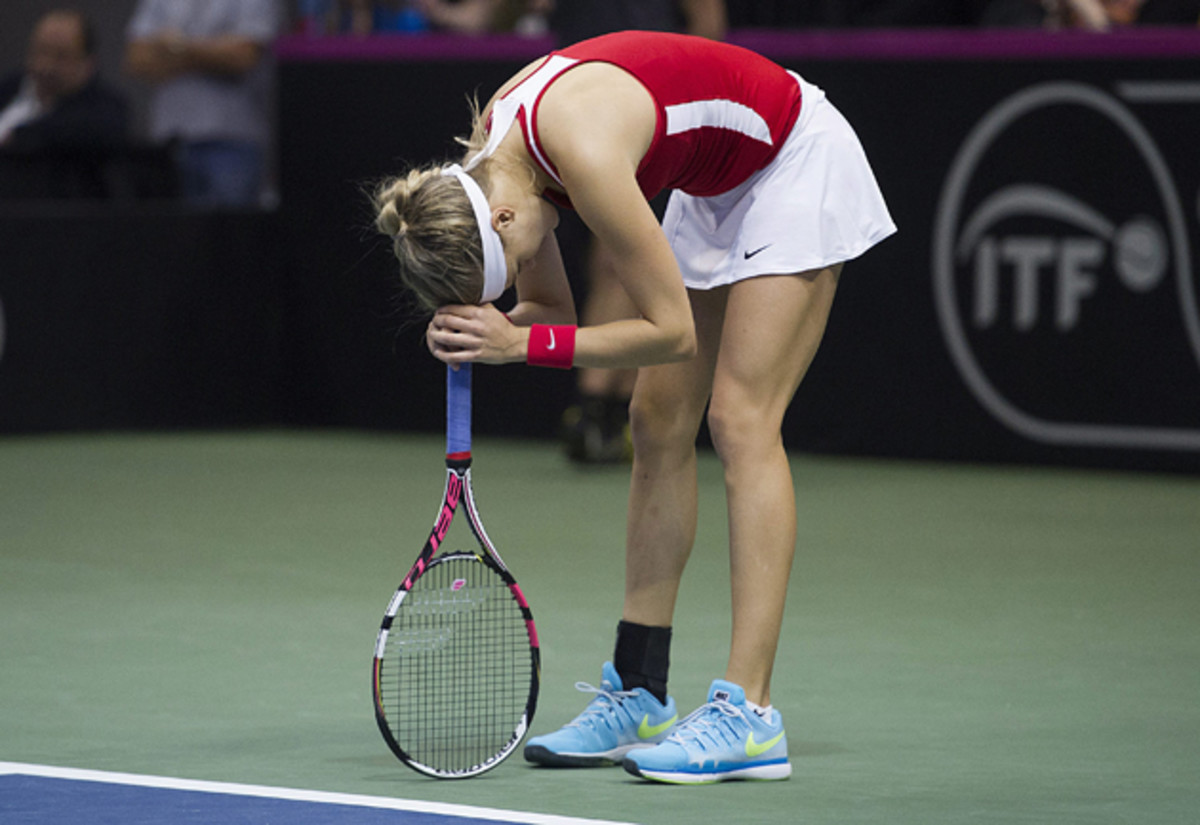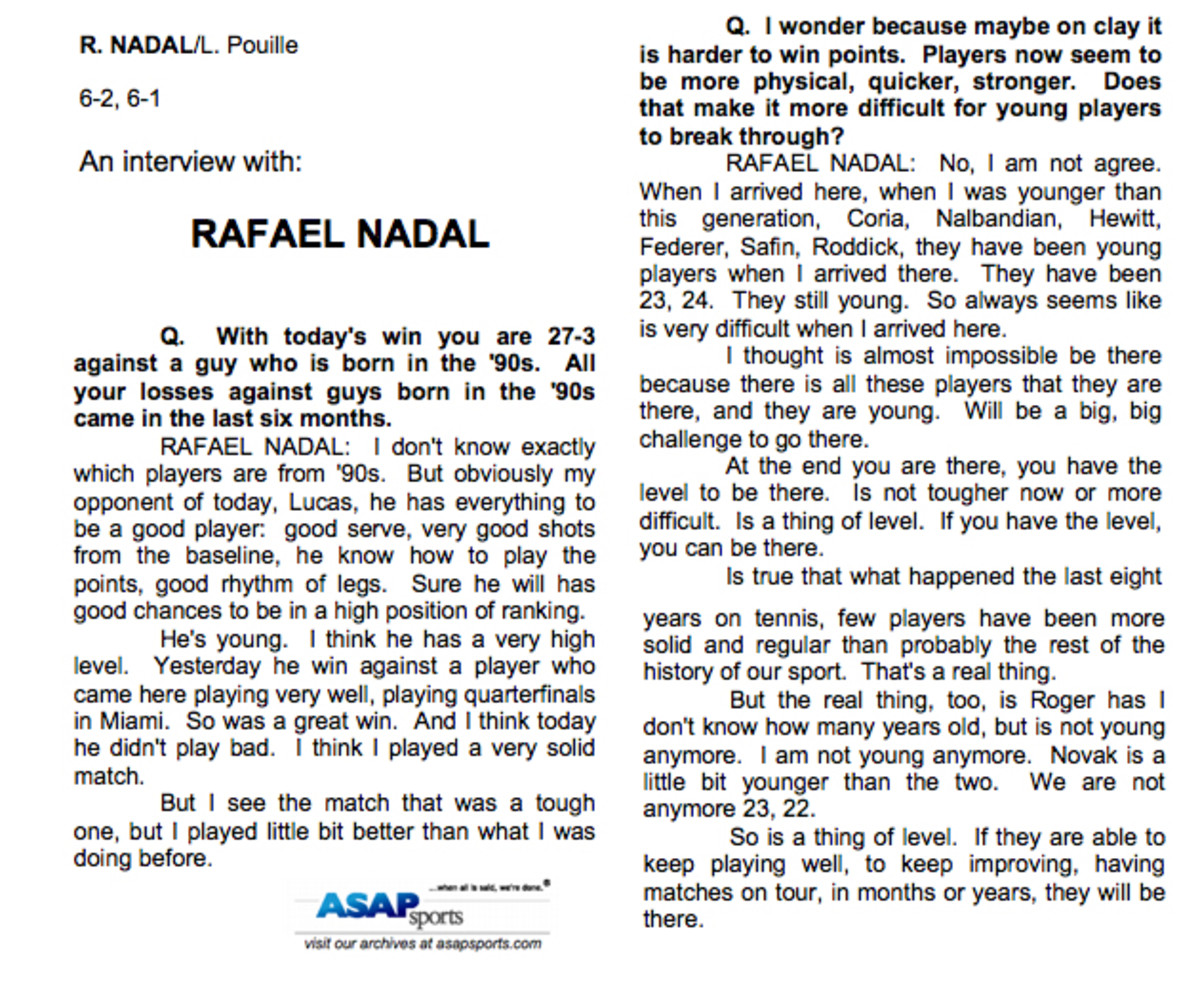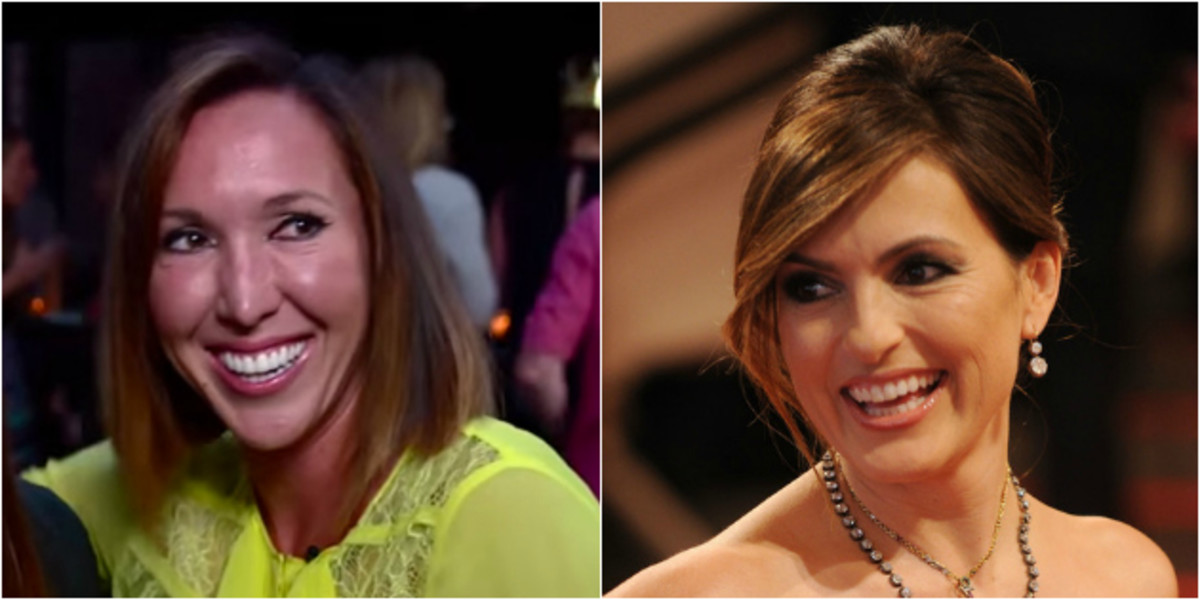Mailbag: Can Bouchard stop her slump? Plus tennis' media conflicts

Have a question or comment for Jon? Email him at jon_wertheim@yahoo.com or tweet him @jon_wertheim.
Is there anyone in the WTA in more need of a—wait for it—shake-up more than Genie Bouchard? Following shakegate (can we still gate things, or is that too 2014?) and an abysmal stretch, what's your advice for a struggling Bouchard both on and off the court? While she's always been a bit Sharapovian in her approach to other players, at least Maria backs it up with five Grand Slams. New coaching comes with changes that take time, but combine that with entitlement and a poor attitude, it looks like Bouchard needs to make some changes.
—Matt, Toronto
• To answer your most pressing question, I submit we have reached a point of “Gategate,” an era of scandalous cliché, whereby every crisis, no how trivial, gets that damn suffix. Enough already. Unless we’re talking about Bill, Antonio, Henry Louis, or openings in fences, please, no more gates.
As for your other question, yes, Genie Bouchard’s Yelp ratings have taken a beating lately. I bet half of our reader mail this week pertained to her Fed Cup behavior and flagging results. A Vancouver reader lamenting, “That is so un-Canadian!” may have been my favorite critique.
Daily Bagel: Halep on Bouchard's handshake snub, more Canada tennis
Bouchard is finding out an immutable truth of sports. As Matt implies, there is indeed a sliding scale for behavior. If you breach decorum, it's one thing. If you then fail to win, it's quite another.
There’s no question that Bouchard’s game is in the breakdown lane right now. And there’s little doubt that all of the churn in her life—new coach, new agent, new expectations—are having an effect on her tennis.
But the tennis sophomore slump has become almost axiomatic. So many players have experienced this adjustment period. Sloane Stephens. Petra Kvitova. Novak Djokovic won his first major in 2008; it took him three yeas to win another. Bouchard may not have been as good as projected in 2014—a future No.1, many called her—but she sure isn't as bad as she is being cast now.
Her ranking will likely fall after this spring and summer. Then, under lighting less intense, she’ll recover. We see it all the time. Meanwhile, with any luck, she'll get some advice from the new handlers who will minimize the unforced errors off court. All of which is to say: let’s give this more time before making sweeping conclusions. Can we shake on that?

Rafael Nadal seems to be having a rough time this year, yes? But, nobody says that he is declining, or losing his edge. When Roger Federer started having trouble, people get mumbling that it was the beginning of the end of his career. Why do you think this is?
—Amy
• The hardcore Federer and Nadal fans sometimes resemble siblings in the backseat. “It’s so unfair! How come I always get yelled at for playing on my phone, but he never does? How come he never had to try the lamb skewers before getting baklava for dessert? Double standards, Mom! It’s so obvious you like him more, Dad!”
Novak Djokovic makes history, wins second Monte Carlo Masters title
First, I would argue with the premise here. In both cases, you have elite champions whose results have slipped. It seems reasonable for fans to wonder what’s going on and whether the end is near. It doesn’t mean you evict these champions from the palace or start writing them out of the script. It doesn't mean you wish them ill. It doesn't mean you don’t hope this is just a dip and that a regression to the mean—the mean being relentless winning—is coming soon. But I don't think fans are out of line suggesting the “beginning of the end.” These are simply the rules of the road for sports.
As for Nadal, specifically, his results over the last ten months speak for themselves. But he himself has spoken openly about deficiencies lately. His game has also been so grueling and physical that it stands to reason that eventually his body will tap out. Whether we’re nearing that point—let’s hope not—or whether this is just a slump while his body and confidence recover, well, that remains to be seen.
• We pause here to note that we had some questions and comments about the (very public) breakup of Stan Wawrinka’s marriage. This has gotten very ugly, very quickly. (So much for Swiss neutrality.)
[tweet=https://twitter.com/Renestance/status/590232168917499904]
I will say only this: Pro athletes may run faster, jump higher and hit a ball more forcefully than you and I. But they aren’t immune to, well, I believe the technical term is life. Stuff happens. Siblings take ill. Parents age. Marriages disintegrate, spectacularly on occasion. Sometimes tennis players lose because they are missing their targets or they are playing too many balls to the forehand side. Other times, they lose because of factors to which even the most inside insider isn’t privy.
It was one thing for Tennis Channel to employ active coaches as commentators. But haven't they crossed a line by having a coach provide commentary on his charge's match, as Justin Gimlestob did on the Isner–Nadal match in Monte Carlo? You have touched on the myriad conflicts of interest that have already been tolerated but this was a step too far.
—Jeff W., Columbus, Ohio
• Full disclosure: Justin is a friend and colleague. And this is ultimately my point. Full disclosure, that is. Justin is Isner’s coach—and obviously has skin in the proverbial game. But that’s no secret. In fact, it figures prominently in the commentary. The viewer understands the relationship, considers this obvious and latent rooting interest, and processes what follows accordingly. I think of this as akin to, say, Donna Brazile on CNN. We know she is head of the Democratic National Committee and the former campaign manager for Al Gore; and we take that for what it’s worth. The thinking/hope is the expertise and singular perspective outweighs the fact—the obvious fact—that the commentator has a vested interest in the result. Nobody is being duped. There’s total transparency. You might put it like this: the conflict is so obvious, it’s not even a conflict.
Aces and Faults: Pereira becomes first Brazilian woman since '88 to win title
To me, far more insidious and corrosive are the undisclosed media conflicts. Broadcasters have financial relationships with organizations and companies that are not made clear to the public; but clearly impact what they say (and don’t say) and how they cover the sport.
And let’s be clear: tennis’ web of conflicts goes way beyond media, too. Management agencies that represent players have seats on the tournament side of the ATP and WTA boards—and thus agitate to suppress the wages of the same players they represent. Agents represent multiple players in search of the same endorsement deals and appearance fees. The terminally dysfunctional USTA was embarrassed on the eve of last year’s U.S. Open when the New York Times popped this story. You know you’ve reached the depths when you're a (cough, cough, harumph, harumph) non-profit and, yet, the newspaper of record needs to include an infographic flow chart to depict your web of conflicts.
A friend of mine encouraged me to let the “conflicts thing go," explaining the sport is congenitally incestuous and it’s pointless to expect any different. He’s probably right. But I still think that this really stunts tennis’ growth and makes the sport come off as bush-league.
Quick story: when Jay-Z became a sports agent, he not only had to sell his stake in the Brooklyn Nets; he had to sell his tiny stake in the Barclays Center arena. That’s how seriously the NBA takes conflicts of interest. How foolish, amateurish and club-ish does tennis look by contrast?
The data is overwhelming that there is a serious and unprecedented dearth of achievement on the part of the, say, 20- to 25-year-old players. The collective response to this by tennis writers has been to hypothesize that tennis has suddenly become a more physical game, more suited to older players....as if it wasn't physical in Federer/Nadal/Djokovic's younger days. Anyway, Nadal rejects the notion. It's always been difficult to break through. The plain fact is that the younger players just haven't met the challenge. Which tennis journalist is going to be the first to accept that this is a real thing and investigate why?
—Michael Roetzel
• Here are the results of a tireless investigation: Federer, Nadal and Djokovic (and we tend to err on the side of inclusion and add Murray) are really friggin’ good tennis players. Four guys have won more than 90 percent of the majors played over the last decade. It’s not just the 20- to 25-year-olds who suffer for this. It’s everyone else—Tomas Berdych, David Ferrer, Gael Monfils—whose results pale in comparison. This is like squeezing a balloon. The number of big trophies stays constant. If one end weren’t inflated we wouldn’t be talking about a “dearth of achievement” on the other end. But another way: if Raonic and Dimitrov and Nishikori were picking off majors, we would be talking about the slide of Federer and Nadal and Djokovic and questioning how good they were when they couldn’t withstand a challenge from the younger set.
Here are some interesting comments from Nadal on the Lost Boys:

History was made at the Miami Open when all of the No. 1 seeds and defending champions in men's singles & doubles and women's singles & doubles were victorious (with the exception of Mirza, since Hingis/Lisicki won in 2014). Has this ever happened before?
—Michael Noche, San Francisco
• Here’s Sharko on this point from last week’s Mailbag: Not sure about the women but for the men the last time this happened was: 1980 and 1981 Sydney Indoor. McEnroe won both singles and Fleming-McEnroe won both doubles.
11 first-quarter thoughts, Djokovic's chances at a Grand Slam, more mail
I understand the need for gender neutrality but I and my family feel that “ball kid” is inelegant and, well, goatish. We suggest either “ball youth” or “ball hops.”
—Paul Murphy
• Ball hops is clever. Though if we’re opening this up to puns, well, duck and cover. Courtesans. Golden retrievers. Felt helots. That kind of thing….
You’d think that given Nadal has won more Grand Slams, more Masters 1000s and more titles overall than Djokovic, he’d also have earned more prize money. Surprisingly, it’s Djokovic who has actually earned $77 million to Nadal’s $72 million. For that matter, Djokovic is only $12 million behind Federer, who has more than double his number of Slams! Of course it’s the endorsements that count, but does this indicate a lot more money being put into tennis post 2011? Perhaps Djokovic has also had greater consistency at the big events over his career—after all, he’s just passed Nadal for weeks at No. 1. Either that, or clay court events simply don’t pay as well as hard court events!
—Dounan Shao, Sydney, Australia
SI Tennis Podcast: Jack Sock on his recent ATP title, the Royals and more
• I wouldn’t fixate too much on the money. Your speculation is correct: the recent prize money increases have been dramatic and will skew toward the most recent winners. For instance: Djokovic earned $900,400 for winning Indian Wells last month. When Nadal won the event in 2007, he took home $500,000.
Remember, too, that Nadal has missed considerable chunks of time. He’s missed at least one Slam in four of the last six years. If he averages $1 million per major, well, that’s half the difference right there. Currency fluctuations are interesting, too. Consider prize money differential when the Euro is trading at 1.4 U.S. dollars versus the current 1.07.
A larger point: to miscegenate metaphors, Djokovic is nibbling on the edge of the GOAT conversation. That he has won more Masters Series titles than Nadal and has spent more time at No. 1 is evidence of this. For the 100 days of 2015, he has been darn near untouchable. If he sustains this level of play, we will need to change the discussion accordingly.
Trivia question: Who was the last American to win the Monte Carlo tennis championship and in what year? If you print the question and answer, my 86-year-old friend, Hugh Stewart, will be very happy, as he does not view the answer as so trivial.
—J Marrack, Honolulu
• I’m guessing Hugh Stewart in 1956. (Actually I cheated and looked this up. One interesting tidbit: Jimmy Connors reached the finals in 1981 but his match against Willie Vilas was “abandoned” due to rain.)
Shots, Miscellany
• Here’s an SI Vault Podcast on the story of two (two!) tennis Hall of Famers who survived the Titanic.
• Here’s our first SI Tennis Podcast in a while: Jack Sock, unabashed lover of clay courts, stops by. (Note on the SI Tennis Podcast: You will soon be able to subscribe in iTunes—for now, sit tight and check back at SI.com/tennis or on the @SI_Tennis Twitter feed for new episodes.)
• We love Ivo Karlovic. But we're going to pick on him, pursuant to our discussion of players claiming they want a clean sport, but then complaining about the anti-doping protocol. The other day, he tweeted:
[tweet= https://twitter.com/ivokarlovic/status/589783917324062720]
You feel for Karlovic and it sounds like a lousy inconvenience. But as a friend (who called my attention to this tweet) rightly put it: “These public displays of annoyance seem to undercut the notion that keeping the sport clean is a paramount concern, no?”
• Press releasing: To aid in the continuing effort to increase sports participation in the U.S., particularly among youngsters, the TIA has announced a “Try Tennis Free” campaign that will run throughout the month of May.
• Gen writes: In your April 15, 2015, Mailbag, Jeff of New York made an observation about Arantxa Sanchez and Albert Ramos last names "becoming" Sanchez-Vicario and Ramos-Vinolas. The explanation for this "change" has to do with last name usages that are different between Spanish and other languages like English.
Spanish last names typically have two parts—father's last name and mother's last name. It is customary for the father's last name to come first followed by the mother's. Each last name may be made up of multiple words. Example: Martín Fernández de Córdoba Velasco, Fernández de Córdoba is the first last name coming from Martín's father while Velasco is the second last name coming from Martín's mother.
SI Vault Podcast: Jon Wertheim on 'Unsinkable,' a Titanic story
Spaniards may choose to use one (the first, the father's) or both (father's and mother's) last names depending on the occasion. Using one is typically informal and using two is typically formal, as in official documents.
In Spanish usage, these two last names are not connected with a hyphen. The hyphen is typically added so that other people, like English speakers, can recognize that, in the example of Arantxa Sanchez-Vicario, Sanchez-Vicario is a last name, rather than Sanchez is a middle name and Vicario is a last name.
So this is very different from Justine Henin who "became" Justine Henin-Hardenne because of her marriage to Pierre-Yves Hardenne, and then of course changed back. Spaniards do not typically add the last name of their spouses to their own last names.
Watch List: Sharapova, Halep lead Stuttgart field; Nadal in Barcelona
So Arantxa and Albert's names didn't "become" anything except in usage. They may have decided to use their full (two) last names later in their career, or others started referring to them by their two last names—which is normal and common in Spanish usage—and this preference became widespread.
I hope this explanation is of use. I've been reading your column for years (decades now?) and you are quite right to praise tennis for its international nature. Since it's so international, it's helpful to understand that other peoples have other customs, including last name usages.
• Press releasing: The WTA announced that Li Na has been appointed as the Tournament Ambassador of the WTA Elite Trophy Zhuhai event in November.
• Shlomo Kreitman of Passaic, N.J. has LLS: I never noticed it until I watched this funny video of Jelena Jankovic and Andrea Petkovic, but how could we all have missed Jelena's resemblance to Olivia Benson from Law & Order (Mariska Hargitay)?

